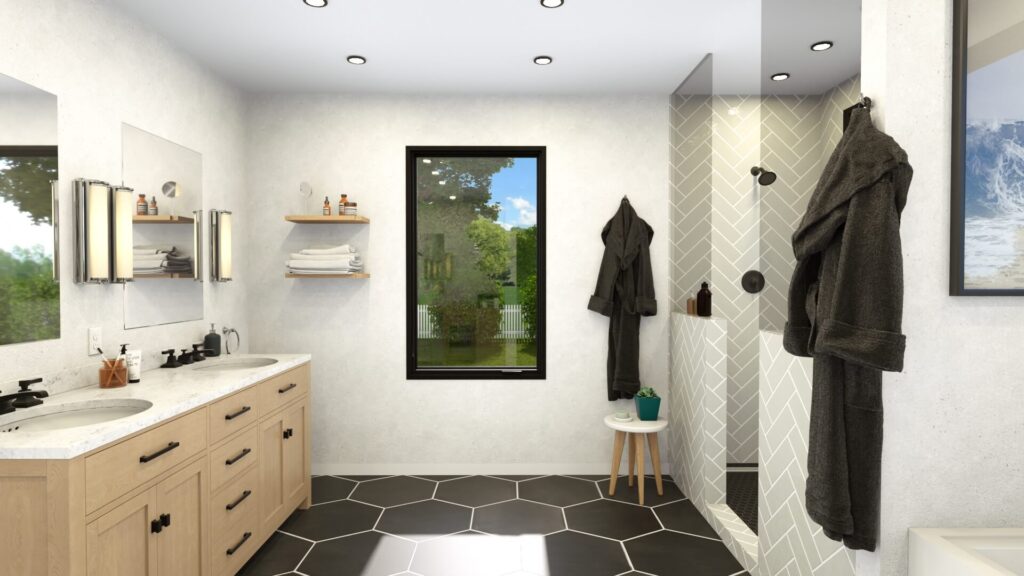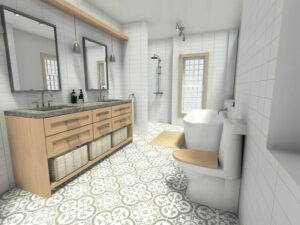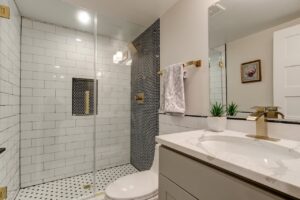When Jennifer and Mike moved into their new home, they were excited about customizing every room to suit their needs. But when they reached the bathroom, they found themselves stuck. Should they choose a compact, efficient space or indulge in a more luxurious, spa-like environment? The size of the bathroom suddenly became a crucial decision point. Like many homeowners, they wondered: What is the standard size of a bathroom, and how much space do they need to balance function with comfort?
This is a common dilemma faced by many homebuyers and renovators. Bathroom size can influence how comfortable and functional the space is, its aesthetic appeal, and potential resale value. In this article, we’ll explore the standard dimensions of different types of bathrooms and provide statistics and expert insights to help guide you in choosing the right bathroom size for your home.
The Standard Sizes of Bathrooms
Bathrooms come in various sizes, depending on their purpose and design. While the exact dimensions can vary, there are industry-standard measurements that many builders and architects follow. Here’s a breakdown of the most common bathroom sizes.
- Half Bathroom (Powder Room)
A half bathroom, known as a powder room, is typically the most minor type, containing only a toilet and a sink. For convenience, these bathrooms are commonly found in smaller homes, guest spaces, or nearby living rooms. HomeAdvisor says the average size of a half bathroom is between 18 to 32 square feet, with the standard dimensions being around 3 feet by 6-8 feet.
This compact size is ideal for homes with limited space, but guests still need an extra bathroom. Despite the smaller footprint, half bathrooms can be stylish and functional with the right design choices.
- Full Bathroom
A full bathroom usually contains four main elements: a toilet, a sink, a shower, and a bathtub (or a shower/tub combo). The size of a complete bathroom can vary depending on the layout, but the average length is about 40 to 60 square feet. The most common dimensions for a small full bathroom are approximately 5 feet by 8 feet. This allows just enough space for the essentials without feeling cramped.
Full bathrooms can be much more spacious for larger homes or master bathrooms, often ranging between 70 and 110 square feet, according to The Spruce. These larger bathrooms feature a separate bathtub and walk-in shower, dual sinks, and more storage space.
- Three-Quarter Bathroom
A three-quarter bathroom resembles a full bathroom but typically lacks a bathtub. It includes a toilet, sink, and shower. The absence of the tub allows for a more compact design, making it a popular option for guest bathrooms or secondary bathrooms in smaller homes.
According to Architectural Digest, the average size of a three-quarter bathroom is 36 to 45 square feet, with dimensions around 5 feet by 7 feet. This space is sufficient for a shower, toilet, and sink while maintaining a functional flow.
- Main Bathroom
For those seeking a luxurious and spacious bathroom experience, the main bathroom is often the house’s largest and most elaborate room. These bathrooms are designed to offer ample space for relaxation and typically include a separate shower, soaking tub, double vanity, and plenty of storage.
The average size of a main bathroom can range from 100 to 200 square feet or more. Standard dimensions for master bathrooms are around 10 feet by 12 feet or larger. These larger spaces can incorporate additional features such as walk-in closets, dressing areas, and spa-like amenities, like steam showers or whirlpool tubs.
How Bathroom Size Affects Functionality
When considering bathroom size, functionality is critical. The right size depends on your specific needs, the number of people using the bathroom, and the space available in your home. Here are some factors to keep in mind:
- Space for Fixtures and Movement
In smaller bathrooms, it’s essential to consider the placement of fixtures like the toilet, sink, and shower. Experts recommend a minimum of 15 inches from the bathroom’s centre to the nearest wall or fixture and at least 30 inches in front of the toilet for comfortable use. Similarly, a shower should have at least 36 inches by 36 inches of space for safe movement.
In larger bathrooms, homeowners have the flexibility to create a more spacious layout, allowing for additional features like a separate bathtub or a double-sink vanity. According to the National Kitchen and Bath Association (NKBA), a bathroom should allow at least 21 inches of space in front of any fixture or entrance to maintain comfort and ease of movement.
- Storage Needs
Smaller bathrooms may lack sufficient storage space, so makingit the most of what you have is crucial. Floating vanities, built-in shelving, or recessed cabinets are excellent solutions for small bathrooms, maximizing storage without wasting valuable floor space. For larger bathrooms, especially master suites, homeowners often include built-in cabinetry, linen closets, or walk-in closets.
- Aesthetic Balance
The size of a bathroom also impacts its overall aesthetic. In small spaces, designers often recommend lighter colours, oversized mirrors, and streamlined fixtures to create an illusion of more space. In contrast, larger bathrooms can accommodate bolder design choices, including statement lighting, darker colour schemes, and decorative tile work.
How Common Are Different Bathroom Sizes?
Statistics show that bathroom sizes can vary greatly depending on the age and location of the home. According to a 2021 report from the National Association of Home Builders (NAHB), newer homes tend to have larger bathrooms, especially master bathrooms, compared to older homes.
- In homes built before 1970, the average size of a complete bathroom was around 40 square feet.
- In contrast, homes built after 2010 tend to have full bathrooms averaging 60 to 80 square feet, reflecting the growing trend toward larger, more luxurious bathroom spaces.
The report also found that 50% of new homes feature at least one bathroom larger than 80 square feet, with master bathrooms being the largest.
Global Bathroom Size Comparisons
The standard size of bathroom in feet also varies by country, primarily influenced by culture and available space. For example:
- In the United States, the average size of a complete bathroom is typically around 40 to 60 square feet for standard homes and larger for luxury properties.
- In Japan, where space is at a premium, the average bathroom size is much smaller—around 30 square feet—with the emphasis placed on efficiency and functionality.
- In Europe, particularly in countries like the United Kingdom, bathrooms are often more compact, with full bathrooms averaging 35 to 45 square feet, according to a study by House Beautiful UK.
Future Trends in Bathroom Sizes
As homes continue to evolve, so do bathroom designs. The demand for larger, spa-like bathrooms has risen, especially as homeowners spend more time at home and seek relaxation spaces within their residences. According to Zillow, homes with spacious master bathrooms and luxury features like heated floors or walk-in showers tend to sell for 5-7% more than homes with standard-sized bathrooms.
At the same time, there is a growing trend toward efficient, eco-friendly designs, particularly in urban areas where space is limited. Compact yet functional bathrooms, designed with sustainability in mind, are becoming more popular in cities.
Conclusion: Finding the Right Size for Your Bathroom
Whether you’re designing a half bathroom for guests or a sprawling main suite, the size of your bathroom plays a significant role in its functionality, comfort, and aesthetic. From understanding the standard dimensions to considering your unique needs, finding the right balance is critical to creating a bathroom that fits seamlessly into your home.
Whether you opt for a cosy, compact space or a luxurious, spacious retreat, knowing the standard sizes and layouts can help you make informed decisions and create a bathroom that perfectly suits your lifestyle.






